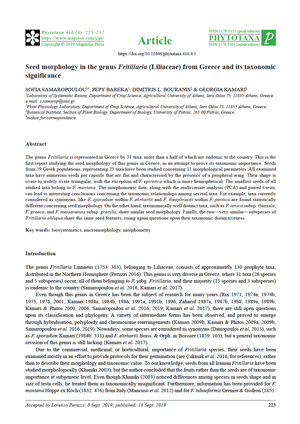NEWS 2019
Seed morphology in the genus Fritillaria (Liliaceae) from Greece and its taxonomic significance
Sofia SAMAROPOULOU1,Pepy BAREKA1, Dimitris L BOURANIS2, Georgia KAMARI3
Phytotaxa 416(4):223-237 (2019)
http://dx.doi.org/10.11646/phytotaxa.416.4.1
1Laboratory of Systematic Botany, Faculty of Crop Science, Agricultural University of Athens, 11855 Athens, Greece
2Plant Physiology Laboratory, Department of Crop Science, Agricultural University of Athens, Iera Odos 75, 11855 Athens, Greece
3Botanical Institute, Section of Plant Biology, Department of Biology, University of Patras, 26500 Patras, Greece
Abstract
The genus Fritillaria is represented in Greece by 31 taxa, more than a half of which are endemic to the country. This is the first report studying the seed morphology of this genus in Greece, in an attempt to prove its taxonomic importance. Seeds from 59 Greek populations, representing 25 taxa have been studied concerning 11 morphological parameters. All examined taxa have numerous seeds per capsule that are flat and characterised by the presence of a peripheral wing. Their shape is ovate to widely ovate-triangular, with the exception of F. epirotica which is more hemispherical. The smallest seeds of all studied taxa belong to F. montana. The morphometric data, along with the multivariate analysis (PCA) and paired t-tests, can lead to interesting conclusions concerning the taxonomic relationships among several taxa. For example, taxa currently considered as synonyms, like F. sporadum within F. ehrhartii and F. theophrastii within F. pontica are found statistically different concerning seed morphology. On the other hand, taxonomically well distinct taxa, such as F. ionica subsp. thessala, F. graeca, and F. messanensis subsp. gracilis, share similar seed morphology. Finally, the two—very similar—subspecies of Fritillaria obliqua share the same seed features, rising again questions upon their taxonomic distinctiveness.




